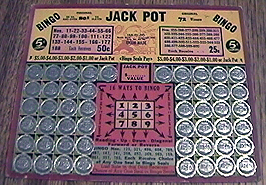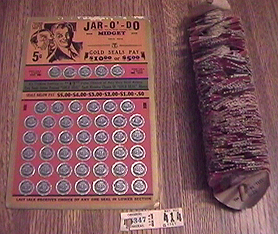Tips for Punchboard Collectors
In recent years, the number of punchboard collectors has skyrocketed, while the number of boards available has continued to decline at a steady pace. In years past you might have found punchboards at nearly any flea market or swap meet. Now, the boards are becoming more difficult to locate, and significantly more expensive to acquire. Particularly nice vintage boards often sell for hundreds of dollars.
Perhaps this increase in punchboard interest can be traced to the fact that several different types of collectors are likely to be searching for punchboards, and bidding against you at auctions. Aside from true punchboard aficionados, there are several other groups of collectors that seek out and purchase punchboards.
Collectors focused on a particular time period (Roaring 20's, Great Depression, WWII, Nifty Fifties, etc.) often acquire punchboards from those eras. Likewise, collectors of antique gambling equipment or mob memorabilia also buy the occasional punchboard. Punchboards were sometimes used to advertise products like cigarettes, liquor, beer, and soft drinks, so collectors of old advertising materials also buy them. Punchboards were often found in bars, barber shops, country stores, and roadside diners… and each of those locations has its share of collectors. Many punchboards featured pin-up graphics, which are valuable to a different set of collectors. Some collectors of slot machines and coin-operated machines also collect punchboards, although I'm not sure what the connection (other than gambling) is.
Punchboard prices have risen steadily, driven by collectors' and dealers' interest. Vintage punchboards can be a great investment, provided that you know what to look for in a collectible board.

|
|
Jar Ticket Award Card
|
One will quite often see the payout card for a jar ticket or spindle game game being offered for sale as a punchboard or as a punchboard label. Punchboards, pushcards and small carded pull-tab games are certainly collectible items. Some collectors may also be interested in the payout card for jar-ticket or pull-tab games. On some older jar-ticket games the payout information was a label which was glued on the jar by the operator so a jar game with the label intact might also be a collectible. Payout cards and bags of tickets were available as individual items which allowed for re-use of the payout cards. The glass jars were normally reused either with the same or with a new label.
Ideally one should determine enough about the punchboard he or she is about to buy to see that it is all there, i.e. that it does not use a payout card or another board as part of a set. Sometimes you may be looking at the payout card and not the board at all. Sometimes you may be looking at a board where many like boards were played against one master payout board or payout card.
As with many collectibles, a punchboard is worth what you are willing to pay for it. This, of course, has a lot to do with how the board ties in with other collectibles a buyer might have. A punchboard (and anything else, for that mattter) is worth exactly as much as someone is willing to pay for it. Punchboards with a particular theme (politics, sports, etc.) appeal to a larger variety of buyers, and hence generally more valuable in the collectibles market.
Girlie boards are always popular but then this did not go unnoticed by punchboard manufacturers. As a result, it is relatively easy to find nice pinup boards at reasonable prices.
Cigarette boards are popular, but these were probably made by the hundreds of thousands and there were many many different variations. Since they were essentially an advertising piece, they found their way into countless stores, pool halls, barber shops and bars.
Pushcards occassionally command unexpectedly high prices. Pushcards were much easier and cheaper to make than punchboards, and a lot more companies made them. Since lots of these were made with blank tops, there has always been a temptation for unscrupulous dealers to invent (or copy) an antique pushcard with a little printing job. Coca Cola, tobacco products, baseball and football collectors are probably the most likely targets for counterfeit pushcards.
Pushcard are a valid collectible, however, particularly since they can usually be slipped in a sheet protector and put away in a notebook, not taking up much space and being relatively easy to show off.
Most collectors are interested only in completely unpunched punchboards or pushcards. There may be nothing wrong with displaying partially punched boards as decoration, but if any of a board's punches are missing, so is a good bit of its value to collectors. A partially punched board is much less likely to appreciate in value than a completely pristine one.
The overall appearance of the board is also important, as is the quality of the original design.
If you find a board that interests you, take a good look at it before you buy it. Examine the board to see if everything appears original. Many boards were designed blank, and labels were affixed to give the manufacturer the ability to completely change the look of the punchboard by simply changing the label. These boards, while attractive, are not as desirable as boards that are printed all in one piece. Some dealers have been known to attach new labels to vintage blank boards, then sell the entire board as vintage. Don't be fooled… take a good look.

|
|
Complete set of Jar Tickets and Payout
Card
|
The first question you should answer is "Is this a punchboard?" This may sound like an obvious question, but I've seen many dealers try to sell a number of different items as punchboards that were, in reality, something else. In most cases, however, I don't think that the dealers were trying to misrepresent what they had, they simply didn't know the difference. The most common item I see dealers mistake for punchboards are jar ticket game award cards. The mistake is an easy one to make, if you aren't familiar with the genre. Both the award cards and punchboards are basically square with a grid of holes or seals covering the face. Both also feature payoff information, bright graphics, and the same general look. The difference is that a punchboard is a self-contained game. All you need to operate it is the punchboard itself, and the metal punch. A jar ticket award card is only part of a game. In order to play it, you would also need a jar (or spindle) full of numbered tickets. Jar ticket award cards represent, in my opinion, a respectable item to collect in their own right… I just hate to see people buy or sell an item that they have wrongly identified.
You'll also see a lot of pushcards called punchboards, and vice versa. There is little distinction between the two forms, when you get down to it. As a rule, people spend more for punchboards than they do for pushcards. A good question to ask if you hear that someone has a punchboard for sale is "How thick is it?" If the answer is more than a quarter of an inch, it's probably a punchboard. Anything under a quarter of an inch is probably a pushcard or something else entirely.
Occassionally you may find a punchboard "top" for sale. A "top" is the outermost front layer of a punchboard, usually with the hole-covering foil attached. Punchboard salesmen didn't bother to carry around entire punchboards, which would have been very bulky and heavy. Instead, they just carried the top, which showed what the board looked like but was very light and easy to carry from city to city. A salesman might only be able to pack three or four punchboards, but he could carry an entire case of tops.
When considering purchasing a punchboard, you should take an inventory of the board's features. Does it have the original punch sealed on the back? Is it a "protected" board? Is it designed to lie flat on the counter, or does it have an easel attached? Does it have a bonus game (cards, seals, etc.?) Does it have sports, pin-up, wartime, or political graphics? Does it advertise a well-known product? Is the shape of the punchboard unusual? Are the graphics particularly appealing? Does it have rivets (an early anti-tampering tactic) in the corners? Any of these special features will make a board more desirable and valuable. Check out the Larceny section for more information about judging the desirability of a particular punchboard.
A punchboard's features can also help you to determine its age. If you see a punchboard that advertises Lucky Strike cigarettes, for example, look to see if the Lucky Strike packages are colored green. Lucky Strike stopped using green ink in their packaging at the beginning of World War II, so boards that feature the green packages tend to be from the 1940's or before.
Most of all consider the board's overall appearance when determining how much you would be willing to spend for it. As with nearly all collectibles and antiques, condition is extremely important. If the punchboard is appealing to you and you can live with the price, then by all means buy it immediately. If you pass by a punchboard at an antique show or flea market, then later decide to buy it, it probably won't be there when you go back.
If you are buying punchboards as decorations (rather than as pure collectibles) then don't get too hung up on getting boards in perfect condition. A few scuff marks and missing punches can often give a board character as a conversation piece. You may find that a board with a few punches gone is just what you're looking for. Sure, it may never be worth thousands of dollars, but don't let that keep you from buying a particularly nice punchboard with a few punches gone. If you like the way it looks, and have a place to display it, then buy it and be happy with it.
Don't forget to bookmark Punchboard.com!